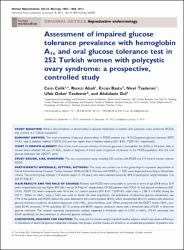| dc.contributor.author | Çelik, Cem | |
| dc.contributor.author | Abalı, Remzi | |
| dc.contributor.author | Bastu, Ercan | |
| dc.contributor.author | Taşdemir, Nicel | |
| dc.contributor.author | Tasdemir, Ufuk Goker | |
| dc.contributor.author | Gül, Abdulaziz | |
| dc.date.accessioned | 2022-05-11T14:35:50Z | |
| dc.date.available | 2022-05-11T14:35:50Z | |
| dc.date.issued | 2013 | |
| dc.identifier.issn | 0268-1161 | |
| dc.identifier.issn | 1460-2350 | |
| dc.identifier.uri | https://doi.org/10.1093/humrep/det002 | |
| dc.identifier.uri | https://hdl.handle.net/20.500.11776/8258 | |
| dc.description.abstract | What is the prevalence of abnormalities in glucose metabolism in patients with polycystic ovary syndrome (PCOS) and controls in a Turkish population? The total prevalence of glucose abnormalities in PCOS patients was 16.3 [impaired glucose tolerance (IGT) 14.3; type 2 diabetes mellitus (T2DM) 2] and was higher than in healthy subjects (IGT 8.5; T2DM 0, respectively). One of the most common markers of chronic glycemia is hemoglobin Alc (HbA(1c)). However, little is known about whether the use of HbA(1c) results in diagnosis of more cases of glucose intolerance in the PCOS population than the oral glucose tolerance test (OGTT) alone. This was a prospective study, including 252 women with PCOS and 117 control women without PCOS. The study was carried out in the gynecological outpatient department of Namik Kemal University Hospital, Turkey, between 2010 and 2012. Women with PCOS (n 252) were diagnosed according to Rotterdam criteria. The control group included 117 women (aged 1745 years) who were selected randomly. BMI of participants ranged between 15.6 and 47.9 kg/m(2). Patients with PCOS were comparable to controls in terms of age (24.8 versus 25.9 years, respectively) and had higher BMI (26.1 versus 24.9 kg/m(2), respectively). Of 252 patients with PCOS, 41 had glucose intolerance (IGT 14.3; T2DM 2) when compared with 10 of the 117 control patients (IGT 8.5; T2DM 0; odds ratios 2.08; P 0.045) during the OGTT. When an HbA(1c) value 5.6 was used to divide the total population, the prevalence of abnormal glucose metabolism was 7.9 in the patients with PCOS, below the value detected in the control patients (8.5), which showed that 20 of 41 patients with abnormal glucose tolerance would not have been diagnosed, if the HbA(1c) alone had been used. When compared with the OGTT results, HbA(1c) provided 52.4 sensitivity, 74.4 specificity, 67.1 positive and 60.9 negative predictive values with a threshold value of 5.6 in abnormal glucose tolerance. The receiver operating characteristic analysis suggested a threshold value of 5.35 in HbA(1c) (75.6 sensitivity and 52.6 specificity) for the prediction of abnormal glucose tolerance. This study did not involve weight-matched healthy subjects, which may cause a difference in prevalence of abnormal glucose metabolism between the groups, and the results are limited to an unselected population of patients who have the full PCOS phenotype. In addition, the incidence of T2DM among the first-degree relatives and 2-h insulin levels could not be reported in full. Further investigation of the efficacy of HbA(1c) for the prediction of abnormal glucose tolerance should be undertaken in long-term prospective studies and in different geographic populations. At present, the only way to reliably detect abnormal glucose metabolism in Turkish women with PCOS appears to be using the OGTT. No financial support. The authors have no competing interests to declare. Not applicable. | en_US |
| dc.language.iso | eng | en_US |
| dc.publisher | Oxford Univ Press | en_US |
| dc.identifier.doi | 10.1093/humrep/det002 | |
| dc.rights | info:eu-repo/semantics/openAccess | en_US |
| dc.subject | impaired glucose tolerance | en_US |
| dc.subject | diabetes mellitus | en_US |
| dc.subject | polycystic ovary syndrome | en_US |
| dc.subject | hemoglobin A(1c) | en_US |
| dc.subject | Insulin-Resistance | en_US |
| dc.subject | Diabetes-Mellitus | en_US |
| dc.subject | Plasma-Glucose | en_US |
| dc.subject | Risk | en_US |
| dc.subject | Intolerance | en_US |
| dc.subject | Obesity | en_US |
| dc.title | Assessment of impaired glucose tolerance prevalence with hemoglobin A(1c) and oral glucose tolerance test in 252 Turkish women with polycystic ovary syndrome: a prospective, controlled study | en_US |
| dc.type | article | en_US |
| dc.relation.ispartof | Human Reproduction | en_US |
| dc.department | Fakülteler, Tıp Fakültesi, Cerrahi Tıp Bilimleri Bölümü, Kadın Hastalıkları ve Doğum Ana Bilim Dalı | en_US |
| dc.authorid | 0000-0003-0810-6195 | |
| dc.identifier.volume | 28 | en_US |
| dc.identifier.issue | 4 | en_US |
| dc.identifier.startpage | 1062 | en_US |
| dc.identifier.endpage | 1068 | en_US |
| dc.institutionauthor | Çelik, Cem | |
| dc.institutionauthor | Abalı, Remzi | |
| dc.institutionauthor | Taşdemir, Nicel | |
| dc.relation.publicationcategory | Makale - Uluslararası Hakemli Dergi - Kurum Öğretim Elemanı | en_US |
| dc.authorscopusid | 24075279000 | |
| dc.authorscopusid | 6506061779 | |
| dc.authorscopusid | 55022842500 | |
| dc.authorscopusid | 23986422400 | |
| dc.authorscopusid | 56499067400 | |
| dc.authorscopusid | 57211995246 | |
| dc.authorwosid | Bastu, Ercan/K-5354-2017 | |
| dc.identifier.wos | WOS:000316698800025 | en_US |
| dc.identifier.scopus | 2-s2.0-84875615930 | en_US |
| dc.identifier.pmid | 23335611 | en_US |



















